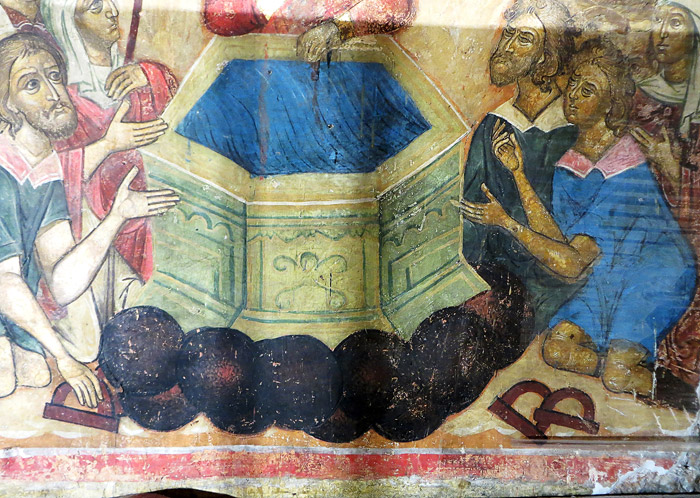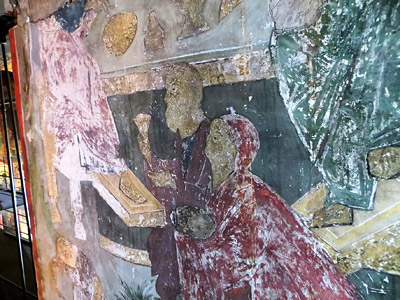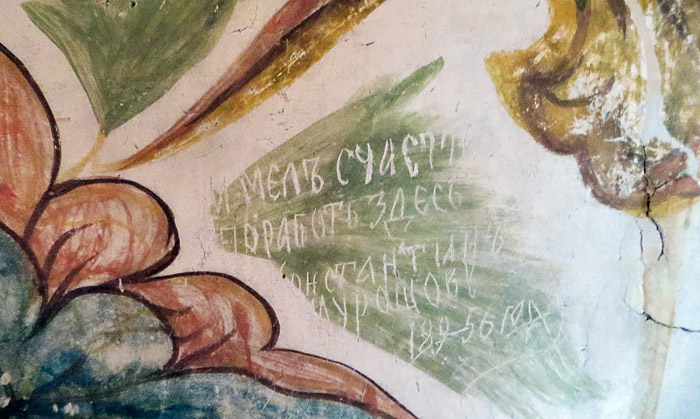
Electronic english version since 2022 |
The newspaper was founded in November 1957
| |
Culture
Revealing the invisible
In issues No.15 and 16 of the weekly, in the article "Looking into the depths of time under the dome of the cathedral," I talked about a trip to the Assumption Cathedral of the Moscow Kremlin together with FLNP employee N.V. Glombotskaya and the participation of the Neutron Activation Analysis Group of FLNP in restoration work. The article did not include the story of the restoration artist of the V.D.Sarabyanov brigade of the Interregional Scientific and Restoration Art Directorate A.B.Grebenshchikova that gave me an exclusive tour during her lunch break. To do this, we descended from under the dome of the Assumption Cathedral to the upper level of the iconostasis.
"The two main periods of painting that we are now restoring here are paintings from the 1940s of the 17th century," Alexandra said. "This is part of the compositions "Annunciation" and "The Origin of the Honest Trees of the Lord." Look at the excellent state of preservation of the "Origin" composition. It depicts cripples and blind people that gather at the well to receive healing. You see, the pieces of wood that the cripples used to move around are depicted. All these faces were covered with an 18th century recording.
The upper part of the compositions fell under the recording - they were not visible because of the icons of the iconostasis. All stages of restoration of the 20th century took place here. The initial, very tough stage, when everything was simply washed, late records were torn off and later, scientific restoration already collected the remnants "from what was." Despite the fact that the Mother of God was visible from behind the icons, she was not washed during the proto-restoration of the early 20th century, but was left under the record. Today, these recordings are only partially removed. The recording was made in oil, repeated the composition, the gold was puttied and gilded. It is interesting that the halo was simply painted on with oil paint of an ocher shade, quite dark. It was located exactly along the contours of the icons standing in front of them. Below, it is presumably a tempera or glue recording that appeared quite early, perhaps at the end of the 17th century. There is also a third recording, very rough, oily. And there was also, this is confirmed by documents, a recording from the 18th century, when only the faces and personal details, arms and legs were covered. In some compositions we managed to peel off this recording; we will transfer it to a new base, only from the "wrong side", from the reverse side. And then we will lay down the soil, put up a preventive tape and the monument will be preserved separately - a fragment of an 18th-century painting from the front side. Currently, we are thinking about how we can exhibit such a fragmentary recording that we shot. This is a relatively rare technology, since it is quite difficult to preserve both the original and the top layers.

"The Origin of the Honest Trees of the Lord"
 |
| Part of the composition - Mary and Joseph |
"Three tiers of such beautiful ornaments," Alexandra goes on describing, "dashing, light, on a plaster base, they were not covered with any whitewash. There are scratched inscriptions from several generations of restorers. "Konstantin Murashov had the good fortune to work here. 1895" is one of them. This is the time of almost the beginning of proto-restoration. There are several more restoration records: somewhere the son of one of the foremen of the craftsmen that worked here at the beginning of the 20th century was noted. He later became a talented restorer.

Scratched inscriptions of several generations of restorers
Next comes a very uncomfortable half-tier. What else do we see? This is the place where the original chapels (transverse beams on which icons were placed - O.T.) from the turn of the 15th-16th centuries were attached; plaster was applied to them. So, they painted three tiers of ornaments and immediately installed the icons. No one has seen this backdrop, but this is a rich royal temple, so even the wall of the backdrop is decorated with ornaments. The commendation chapel, located below, was painted, presumably, by Dionysius.
All this will be covered with the icons that at present stand nearby and no one will see this beauty for a long time," Alexandra completed her excursion. And I thought that I was lucky to see this beauty and share this story with you.
Olga TARANTINA, photo by the author